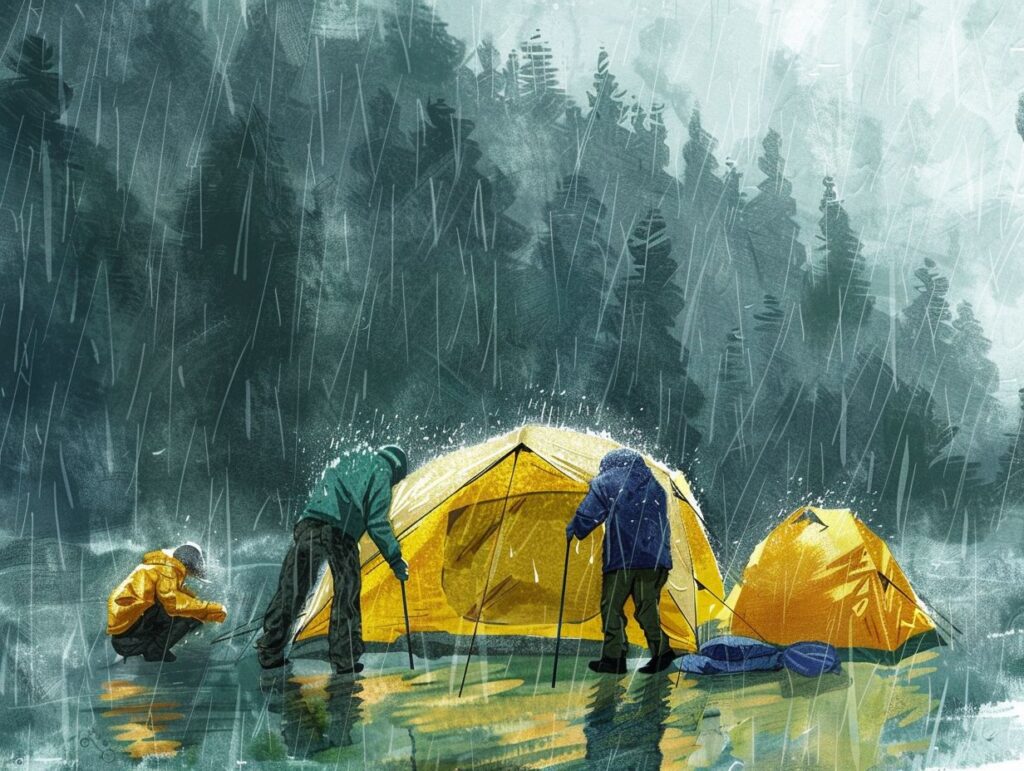Are you a camping enthusiast looking to brave the great outdoors even in less-than-ideal weather conditions? Camping in rainy weather can be a challenging yet rewarding experience if you are well-prepared.
In this article, we will discuss the best tips for camping in rainy weather, including what to consider before, how to prepare, what to do during, and what to do after your camping trip.
So, grab your rain gear and get ready to embrace the elements!
Key Takeaways:
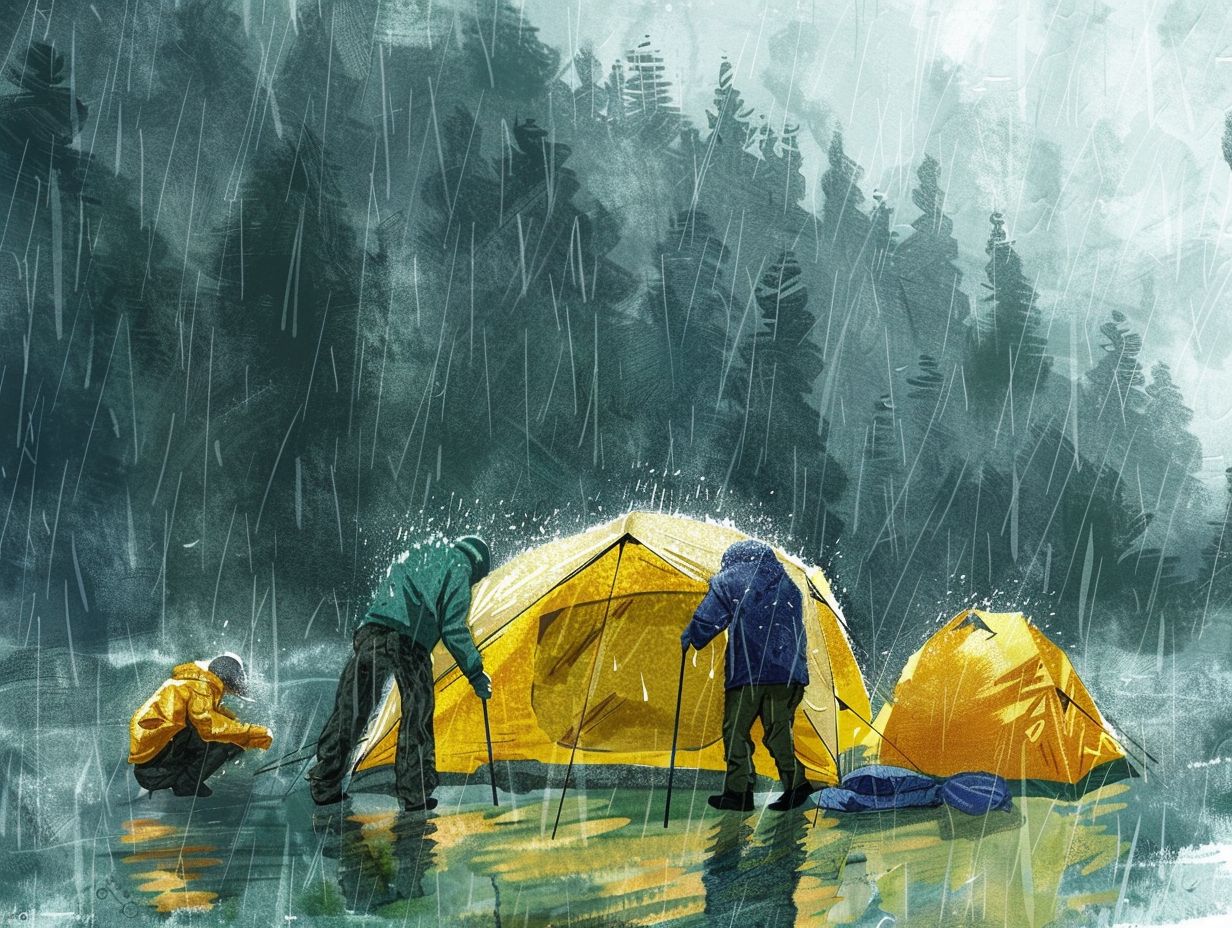
- Always check the weather forecast before camping in rainy weather to ensure safety and proper preparation.
- Properly set up your shelter and pack extra tarps and ground sheets to stay dry and comfortable during your camping trip.
- After camping in rainy weather, make sure to dry and clean your gear, restock supplies, and reflect on your experience to improve for next time.
What to Consider Before Camping in Rainy Weather?
Camping during adverse weather conditions can present challenges, yet it can also offer rewarding experiences. However, meticulous planning and appropriate equipment are essential to ensure that one remains dry and comfortable.
Ahead of undertaking a camping trip in rainy conditions, it is imperative to assess the adequacy of one’s shelter, the extent of outdoor expertise possessed, and the prevailing weather forecasts.
What is the Weather Forecast?
It is imperative to have a comprehensive understanding of the weather forecast when organising a camping trip in rainy conditions, as it enables individuals to adequately prepare for potential heavy rainfall and continuous moisture.
Anticipation of the projected precipitation levels plays a pivotal role in the selection of appropriate equipment, including waterproof tents and rain jackets, ensuring that participants remain dry and comfortable throughout their outdoor excursion.
Additionally, it is essential to review the temperature forecast to guarantee the inclusion of suitable clothing for the prevailing conditions.
Real-time weather updates serve as a valuable resource since they offer timely notifications regarding abrupt storms or shifting weather patterns. This information allows campers to make necessary adjustments to their camping arrangements, thereby promoting safety and facilitating an enjoyable camping experience.
What Type of Shelter Do You Have?
The selection of shelter for a campsite plays a crucial role in ensuring protection from inclement weather conditions, with options varying from poly-cotton canvas tents to synthetic shelters and waterproof tarps.
It is imperative to focus on the waterproofing capabilities of the chosen shelter, particularly by verifying the effective sealing of tent seams to prevent any potential leakage.
Along with choosing a waterproof tent, the utilisation of supplementary tarps can provide an added layer of defence against heavy rainfall.
By strategically positioning extra tarps, a protective barrier can be established to safeguard the primary shelter and outdoor spaces from water infiltration, thereby ensuring dryness and comfort for both individuals and equipment throughout the outdoor expedition.
What is Your Level of Outdoor Experience?
The extent of an individual’s outdoor experience significantly influences their ability to effectively manage camping in rainy conditions, as experienced backpackers and hikers often possess the requisite skills and knowledge to quickly adapt to wet environments.
Seasoned outdoor enthusiasts, such as Marco Johnson, have honed their wet weather camping proficiency over years of outdoor excursions, enabling them to confront challenges with assurance and ingenuity.
Organisations like the National Outdoor Leadership School contribute valuable resources and educational programmes to enhance individuals’ preparedness for outdoor activities.
Engaging in camping activities with seasoned groups not only fosters a sense of camaraderie but also provides opportunities for mutual learning, thereby enhancing decision-making capabilities and safety measures when encountering unpredictable weather conditions.
How to Prepare for Camping in Rainy Weather?
When preparing for camping in rainy weather, it is imperative to meticulously inspect all gear and equipment to ensure they are suitable and in proper working condition.
Additionally, one should carefully select appropriate clothing and footwear that are waterproof and provide adequate protection from the rain. Moreover, it is advisable to choose a campsite that offers natural shelter or protection from the elements to enhance the overall camping experience during inclement weather conditions.
Check Your Gear and Equipment
Ahead of embarking on any outdoor adventure, it is imperative to conduct a thorough assessment of all equipment and gear to confirm their optimal condition and adequate waterproofing. This encompasses the utilisation of waterproofing sprays, as well as possessing waterproof bags and jackets.
Commence the preparatory process by meticulously examining the tent for any instances of tears, punctures, or compromised seams. It is advisable to promptly address any identified damage by employing a patch kit or seam sealer to mitigate the risk of leaks throughout the camping excursion.
Subsequently, inspect the sleeping bags to ensure they are devoid of contaminants such as mould or mildew. To bolster their water repellent properties, it is recommended to administer a waterproofing treatment to the tent, sleeping bags, and backpack.
Furthermore, it is crucial to scrutinise the hiking boots for indications of deterioration and apply an appropriate waterproofing agent as deemed necessary. These meticulous measures will ensure a state of readiness to confront diverse weather conditions while relishing the outdoors.
Bring Appropriate Clothing and Footwear
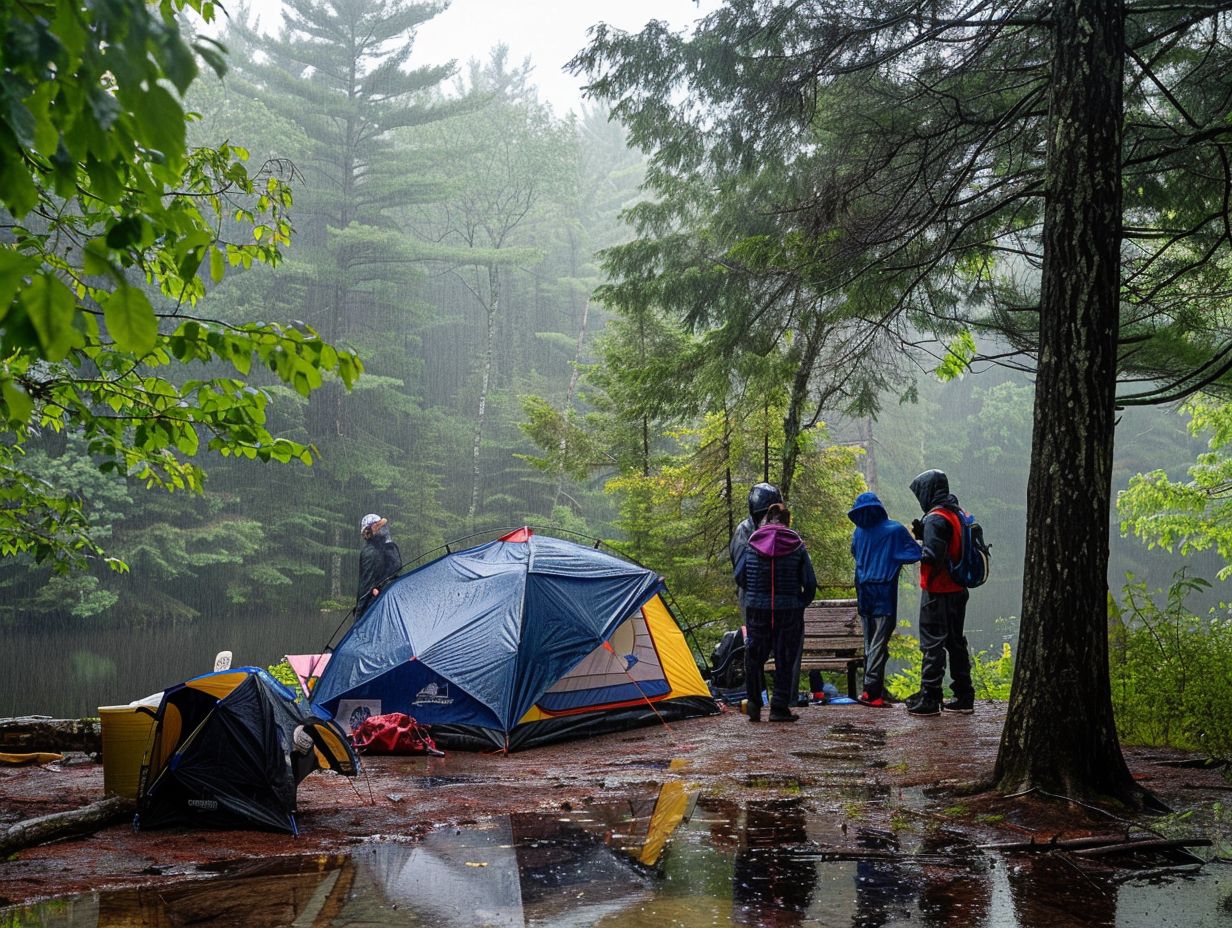
When camping in wet weather, it is crucial to wear appropriate clothing and footwear to ensure comfort and protection. Waterproof attire, such as Gore-Tex jackets and waterproof socks, offers essential insulation and shields from the elements.
Gore-Tex is a popular choice due to its water-resistant properties and breathability, making it a preferred option for outdoor activities during rainy conditions. Along with waterproof socks, it is advisable to don insulated and quick-drying layers to maintain body warmth and dryness.
Selecting waterproof hiking boots with adequate traction is imperative to prevent slipping on wet surfaces. Investing in rainproof trousers and a durable poncho can further protect against the persistent rain, enhancing the overall camping experience despite adverse weather conditions.
Choose a suitable campsite
The selection of an appropriate campsite holds significant importance in ensuring dryness during a rainy camping expedition. Proper site selection plays a crucial role in managing water runoff and minimising condensation within the shelter.
To mitigate the risk of potential flooding or water accumulation around the tent, individuals should seek out elevated areas or locations with efficient natural drainage. During the tent setup process, it is essential to position the tent on higher ground within the campsite to avoid water flow towards it in the event of heavy rainfall.
Additionally, the utilization of a ground tarp underneath the tent can offer an additional layer of protection against moisture seepage through the tent floor. To further enhance protection, orienting the tent door away from the prevailing wind direction aids in reducing the likelihood of rain entering the sleeping area.
Set Up Your Shelter Properly
Properly establishing the shelter is imperative to ensure its waterproof integrity and to provide adequate protection against moisture. This process involves correctly assembling the tent and firmly securing it in place with suitable pegs.
To optimise the tent structure for protection against rain, it is advisable to initiate the setup procedure by meticulously examining the tent seams for any potential gaps or loose threads. The application of seam sealer along these seams will effectively establish a watertight seal.
Selecting an appropriate site with proper drainage mechanisms is essential to prevent the accumulation of water in the vicinity of the tent. Additionally, ensuring that the rainfly is tautly secured and envelops the entirety of the tent structure will facilitate the diversion of rainwater away from the shelter.
To fortify the tent’s stability, it is recommended to anchor it firmly using robust anchor points such as rocks or trees. The utilisation of guy lines can further enhance stability, particularly in the face of strong winds.
Pack Extra Tarps and Ground Sheets
Including additional tarps and ground sheets in your camping kit can provide extra protection and versatility in creating a dry and sheltered environment during unfavorable weather conditions.
Using these additional items involves layering them over your tent to establish an extra barrier against moisture, effectively preventing leaks and promoting a peaceful night’s sleep.
Moreover, these additional tarps and ground sheets can have a dual purpose by helping to set up dry communal areas within the campsite, such as designated cooking or seating spots.
This not only improves the overall camping experience for all group members but also ensures better adaptability to different weather conditions, keeping everyone dry and comfortable throughout the trip.
What to Do During Camping in Rainy Weather?
Throughout your camping trip in unpleasant weather, it is essential to prioritize:
- Maintaining dryness and warmth
- Ensuring personal safety in the event of lightning strikes
- Safeguarding gear and supplies from moisture
- Exploring indoor entertainment options
Stay Dry and Warm
It is imperative to prioritise staying dry and warm when camping in rainy conditions. This can be effectively accomplished by equipping oneself with suitable rain gear, including waterproof footwear, a raincoat, and insulated clothing.
Additionally, ensuring proper insulation is in place is crucial to retaining body heat and preserving warmth, particularly in damp settings. Furthermore, it is vital to maintain the interior of the tent’s dryness by installing a ground sheet to prevent moisture infiltration.
Managing wet clothing should involve the segregation of damp items from dry belongings within waterproof bags. Whenever feasible, airing out clothes by hanging them inside the tent is advisable. Furthermore, changing into dry attire before rest is essential to maintaining body temperature and averting the risk of hypothermia.
Stay Safe from Lightning
Remaining protected from lightning is of utmost importance during rainstorms, necessitating the implementation of specific measures to safeguard oneself and one’s camping party from potential strikes.
When lightning does strike, it is imperative to steer clear of open fields and instead seek refuge in a secure location. It is advisable to avoid tall trees, as they have a propensity to draw lightning towards them.
A recommended course of action involves staying abreast of weather conditions by regularly monitoring updates through the utilisation of a portable weather radio or smartphone.
In situations where seeking shelter is unattainable, assuming a crouched position with only the feet making contact with the ground is advised to minimise exposure to the earth. It is essential to prioritise safety above all else when contending with the hazards associated with a lightning storm.
Keep Your Gear and Supplies Dry
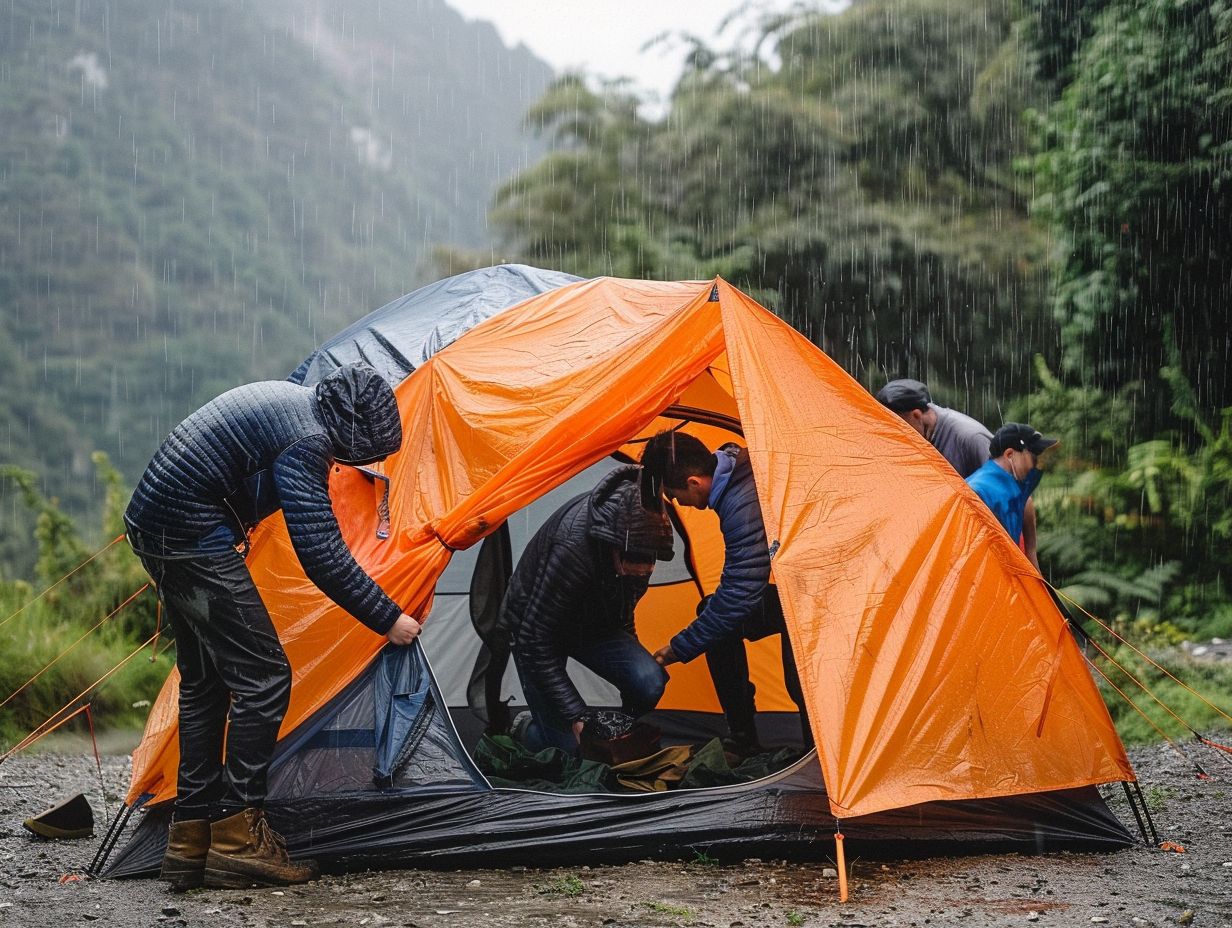
Maintaining the dryness of gear and supplies is imperative to prevent damage and uphold functionality. This can be effectively achieved by utilising waterproof bags and managing condensation within the tent.
Waterproof bags serve as a reliable method to safeguard items against rain or water splashes. It is prudent to store essential items in these bags, particularly electronics, documents, and clothing. Ensuring that gear is stored in a dry location when not in use aids in preventing the accumulation of moisture.
Whilst camping, a useful technique for controlling condensation within the tent involves keeping ventilation openings slightly ajar to facilitate air circulation. Additionally, wiping down the interior walls with a cloth in the morning can assist in eliminating any excess moisture.
By adhering to these techniques, individuals can uphold the optimal condition of their gear for their outdoor excursions.
Stay Entertained Indoors
It is crucial to maintain morale and occupy oneself while camping in inclement weather, particularly when confined indoors to stay dry within the shelter.
Engaging in leisure activities such as playing card games or board games can cultivate a sense of camaraderie among fellow campers, fostering enduring memories.
Immersing oneself in a good book can provide an escape to a different realm, while sharing narratives around a warm campfire can nurture unity and connection.
Anticipating the need for indoor entertainment by packing essentials like a pack of cards, preferred reading material, or storytelling cues ensures preparedness for a rainy day indoors. Consequently, when rain ensues, one is well-equipped to relish quality indoor pastimes.
What to Do After Camping in Rainy Weather?
After camping in unpleasant weather conditions, it is essential to:
- Thoroughly dry and cleanse your equipment
- Inspect for any signs of damage or leaks
- Replenish and restock supplies
- Reflect on your experience to gain insights for future trips
Dry and Clean Your Gear
It is imperative to properly dry and clean your gear following a camping trip in rainy conditions to mitigate the risk of mould and mildew formation and to uphold the functionality of waterproof materials.
To commence the process, establish a dry and well-ventilated space where your gear can be laid out to undergo a complete airing and drying process. The tent should be the first item to address, with its setup in a sunlit location expediting the drying duration. Ahead of dismantling the tent, any residual moisture should be wiped off using a clean cloth.
When tending to clothing items, they should be hung on clotheslines or hangers to facilitate aeration. Thoroughly inspect pockets for any lingering damp contents. Equipment like stoves, cooking utensils, and sleeping bags necessitate a wipe-down with a moistened cloth to eliminate dirt and debris, followed by a comprehensive air-drying period.
Check for Any Damage or Leaks
It is imperative to conduct a thorough inspection of your tent seams and equipment to assess their condition and identify any potential damage or leaks for future utility.
Key areas that warrant careful examination during the inspection of your gear and shelter include the tent seams, zips, guy ropes, and fabric materials.
These components are susceptible to wear and tear, which may result in leaks if they sustain damage. During the inspection process, it is crucial to scrutinise for any indications of tears, holes, or loose stitching that might compromise the structural integrity of the equipment.
In case of minor issues such as small rips or loose seams, individuals can undertake repairs independently utilising patches, sealants, or sewing kits. However, if significant damage is observed and one is uncertain about the appropriate repair methods, it is advisable to seek professional assistance to uphold the optimal condition of the gear.
Restock and Replenish Supplies
It is essential to replenish and restock supplies following a camping trip to ensure preparedness for subsequent adventures, with all necessary kit and equipment readily available.
By consistently monitoring and replenishing consumable supplies, including food, first aid kits, and camping fuel, any last-minute rush or unforeseen inconveniences during future outings can be avoided.
Using a well-structured checklist facilitates the tracking of essential items requiring replenishment, such as non-perishable food items, plasters, antiseptic wipes, and additional gas canisters. Inspection and replacement of expired items are essential to ensure safety and comfort during outdoor activities.
Proactive maintenance of a well-stocked inventory can enhance the camping experience and foster a sense of readiness for any forthcoming adventure.
Reflect on Your Experience and Learn for Next Time
Reflecting on one’s camping experience in wet weather provides an opportunity to analyse any challenges encountered and refine strategies for future outings. Taking into account factors such as gear preparation, site selection, and weather monitoring can greatly improve the quality of your next rainy camping trip.
Recording observations about successful practices, such as equipping oneself with a dependable rain fly and waterproof gear, and identifying areas for improvement, such as dealing with a leaky tent or inadequacy of dry bags, can serve as a roadmap for making constructive adjustments.
Engaging in proactive planning with the inclusion of supplementary tarps, effective waterproofing methods, and contingency plans for outdoor undertakings can have a significant impact on ensuring a more pleasant and satisfactory wet-weather camping experience.
Frequently Asked Questions
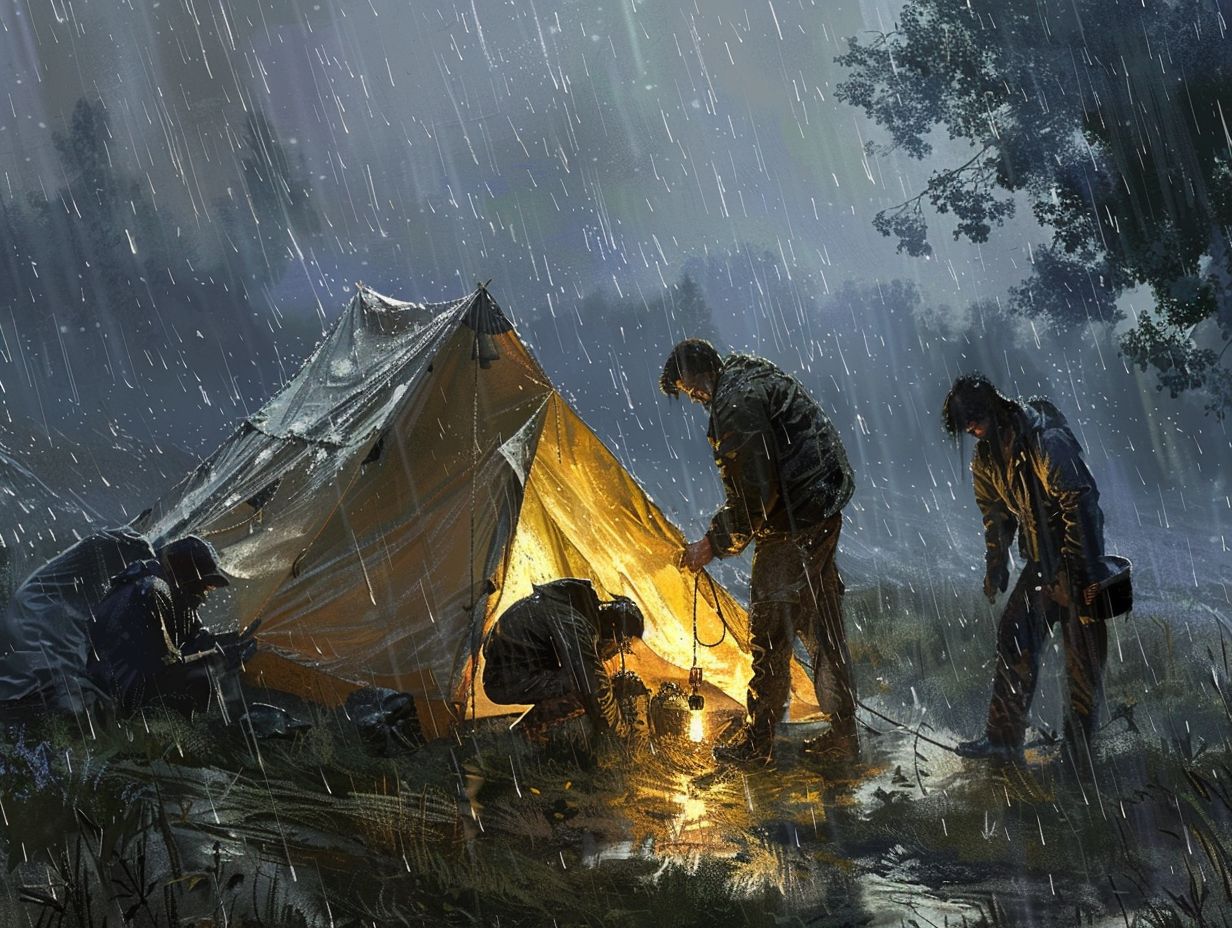
What are the best tips for camping in rainy weather?
1. Always check the weather forecast before your trip and be prepared for rain.
2. Choose a good quality and waterproof tent to keep you dry.
3. Bring extra tarps and a rain fly to create a sheltered area outside of your tent.
4. Pack rain gear such as waterproof jackets, pants, and boots.
5. Use a groundsheet or tarp underneath your tent to keep the moisture out.
6. Keep your belongings and electronics in waterproof containers or bags.
How can I stay warm during rainy camping?
1. Wear layers of clothing to keep your body heat in.
2. Bring a warm, waterproof sleeping bag.
3. Use a camping stove to make hot drinks or meals to warm you up.
4. Stay active by going on short walks or hikes.
5. Make a fire in a designated area if allowed.
6. Use hand warmers or a hot water bottle to warm up your sleeping bag.
What should I do if it starts to thunder and lightning while camping in the rain?
1. Seek shelter immediately in a sturdy building or your car if available.
2. If no shelter is available, avoid tall trees, metal objects, and bodies of water.
3. Stay away from open areas and keep a safe distance from other campers.
4. Wait at least 30 minutes after the last thunderclap before resuming activities.
5. Follow the “30-30 rule”: If the time between lightning and thunder is less than 30 seconds, seek shelter and wait at least 30 minutes after the last thunderclap before going back outside.
6. Stay informed and monitor the weather conditions.
How can I keep my campsite from becoming muddy and flooded in the rain?
1. Choose a campsite on high ground or with good drainage.
2. Avoid areas with natural water runoffs or potential flooding spots.
3. Use a tarp or waterproof groundsheet underneath your tent.
4. Dig shallow trenches around your tent to divert water away from your campsite.
5. Be mindful of where you are walking and try to avoid trampling on wet areas.
6. If possible, set up a sheltered area using tarps or rain fly to keep your campsite dry.
What are some rainy day activities for camping?
1. Bring along some board games, cards, or books to enjoy inside your tent.
2. Use the rain as an opportunity to relax and catch up on sleep.
3. Play in the rain – jump in puddles, have a mud fight, or make rain art.
4. Go on a rainy nature walk and look for unique insects or animals.
5. Use the opportunity to learn a new camping skill, like knot-tying or fire-starting.
6. Bring a portable speaker and have a dance party in the rain.
What should I do if I get caught in a downpour while hiking?
1. Find shelter immediately, such as under a tree or rock overhang.
2. If no shelter is available, put on your rain gear and keep hiking.
3. Keep a safe distance from rivers, streams, or other bodies of water as rain can cause flash floods.
4. Avoid ridges, peaks, and high points as they are more prone to lightning strikes.
5. Stay alert and monitor the weather conditions.
6. If the weather becomes too severe, turn back and seek shelter in a nearby town or campground.

